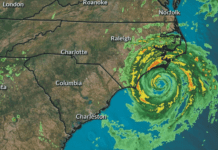Ginger, lollipops, herbal concoctions, aromatherapy, earrings, acupressure, electrical stimulation: These and more have been touted at one time or another as preventing mal de mer, and it seems new non-drug seasickness “cures” are introduced to the market every year.
In the January 2009 issue of Practical Sailor, we reported the results of a survey of 37 experienced offshore sailors regarding seasickness medications. Since Practical Sailor has long been on the lookout for a non-drug therapy that brought effective relief, we also asked the survey respondents about their experiences with “alternative” treatments. Fourteen of the respondents had experimented with non-drug approaches to combating seasickness, all of them in hopes of finding a “natural” way to prevent seasickness that would have no adverse effects. We also had two Practical Sailortesters try these remedies and two recently introduced herbal therapies.
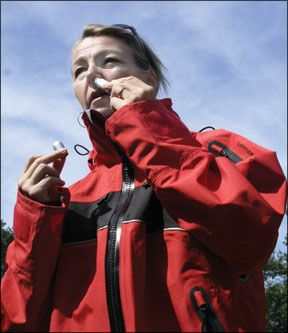
We refrain from declaring any product the best cure for seasickness as remedies will work differently for different people, and our survey group is too small of a sampling to draw firm conclusions from the responses. The following report is meant as a supplemental guide for readers in their own quest for a drug-free treatment.
WHAT WE EVALUATED
Our 14 survey respondents who had tried alternative therapies had used acupressure and electrical-stimulation bands as well as ginger in many different forms, including tablets, candy, and drinks. Our two testers, who have had extensive experience using ginger as an anti-emetic in a variety of sea conditions, tried the Sailors Secret Ginger Caps. They also tested the Davis Queaz-Away Bands, an elastic wrist strap with a plastic bead meant to be positioned on a pressure point on the inside of the wrist, and the Explorer ReliefBand, a watch-like device that fastens to the wrist and delivers tiny electrical pulses to the same pressure point. Our testers also tried two new herbal therapies that none of the survey respondents had used. These are essential-oil based: MotionEaze oil is meant to be applied just under the ear lobe and the Quease Ease is designed to be inhaled to counteract the symptoms of seasickness using aromatherapy.
Past Practical Sailor tests have looked at some of these same products. In the Nov. 15, 2001 issue, a chronic motion-sickness sufferer tested non-drug products and various medications in a moving car and then tried the top performer on the water. Among the products he tried were ginger tablets, SeaBands acupressure bands, and the ReliefBand electrical-stimulation bands. Both wristbands worked best for that tester.
HOW WE EVALUATED
As with seasickness medications, these alternative therapies do not lend themselves to our normal testing procedures. Symptoms vary from individual to individual, as does the efficacy. Instead, we evaluated their effectiveness in two ways: by surveying an experienced group of offshore sailors about their experiences with these therapies and by having two of our own testers use the products both before they started feeling seasick and after they developed symptoms.
Of the 37 sailors surveyed, less than one-third had used one or more of these alternative therapies and, of those, three-quarters had used more than one. We asked each respondent what therapies they had used, whether or not the therapy had been effective, and what, if any, side effects were suffered.
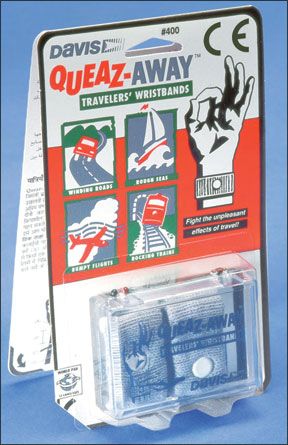
Product photo courtesy of Davis Instruments
ACUPRESSURE BANDS
A number of different acupressure bands are available under various brand names, but all are designed similarly. The non-adjustable elastic bands have a plastic bead on one side that is to be placed on a specific acupressure point on the inside of the wrist that is linked to nausea. The bands are sold in pairs, and one must be worn on each wrist. The Davis Queaz-Away Bands we tested came with precise placement instructions to be sure that the plastic bead is exerting pressure on the proper spot, roughly a few inches above the hand.
Seven of our respondents had tried the acupressure bands, but only three found them effective. The bands prevented seasickness even in severe conditions for one respondent, but two others switched to other medications if conditions deteriorated. One sailor who had experienced some relief in mild conditions believed the effect was purely psychological. The two Practical Sailor testers found the Davis Queaz-Away Bands ineffective for preventing the onset of seasickness symptoms in a rolly anchorage. All users stressed the importance of placing the bands properly and preventing them from slipping out of position. (Directions suggest users to don the bracelets 30 to 45 minutes before boarding the boat.)
Our 2001 tester-the technology is unchanged from our last test-found the Sea-Band wristband, which is identical to the Davis bands, to work as advertised.
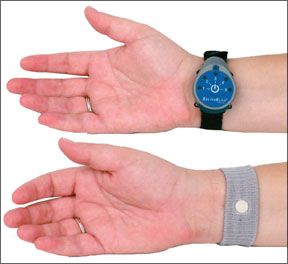
Bottom line: The bands work for some people in some, more mild conditions. They are inexpensive and easy to try, but none of our respondents rely on them.
ELECTRICAL STIMULATION BANDS
The Explorer ReliefBand is a watch-like, battery-powered device that delivers small electrical shocks to the nerves on the inside of the wrist. A dial controls the intensity of the electrical pulse. The instructions describe how to place the band on the wrist properly and how to set the level of stimulation. A gel that is applied to the wrist, under the device, conducts the electrical pulses.
This ReliefBand, which gets consistently high ratings on various Internet websites for car, plane, and cruise ship travel, worked perfectly for our 2001 tester and was his top pick in the test. Unfortunately, it did not work as well for our testers this go round or for the few survey respondents who had tried it. Of the four survey takers who reported using it, only one experienced some relief in mild conditions; none found the bands helpful in moderate to severe conditions.
Two respondents found they had to reapply the gel frequently in wet or sweaty conditions to keep the stimulation going, and one developed a rash, either from the gel or the continued electrical stimulation (every 4 seconds). The bands did relieve mild seasickness symptoms for our two testers while they were moored in a rolly anchorage and offshore, but they did not work when used in severe conditions. Several who used the bands for extended periods reported that the repeated shocks to the wrist became annoying after several hours, and even left the skin underneath feeling “raw.”
Bottom line: At more than $100, the electrical stimulation bands are quite expensive to try. Those who suffer only mild symptoms and would not need to wear the band for days at a time are more likely to find the relief worth the price.
GINGER
Ginger root-based remedies have long been used as an anti-emetic at sea and during pregnancy. Ginger can be used as a spice in food or taken in the form of tablets, carbonated drinks, teas, or candies (homemade or manufactured like the Three Lollies Queasy-Pops mentioned in the February 2007 issue).
Twelve survey respondents had tried ginger in many different forms. Of those surveyed who had tried it, one-third found it totally ineffective, but nearly two-thirds found it relieved mild queasiness without any side effects. The Practical Sailor testers have long relied on ginger ale, ginger tea, and candied ginger to relieve mild symptoms on short daysails or in rolly anchorages. The Sailors Secret Ginger Caps tested for this report worked as well as ginger from other sources in mild conditions. However, our 2001 tester found that taking ginger tablets had no preventative effect nor did it ease his symptoms.
Doctor/sailor Beth Bushnell has researched seasickness extensively in an attempt to help her husband, Bone, who suffers from debilitating seasickness. She said, “The [British Royal Navy] have shown that ginger is as effective as many other options. I now carry ginger beer, ginger biscuits, and use ginger in my early meals… I think Bone has been better with this approach.”

Photos by Beth Leonard
If used extensively, ginger may lose its effectiveness. It no longer works for survey respondent Steph Hammill, who recently returned to cruising after giving birth to two children. “I took a lot of ginger when I was pregnant, and find that I now associate the taste of ginger with feeling sick-which kind of counteracts the whole effect.”
Those who found that ginger relieved some symptoms recommend it and said they prefer it over using drug therapies to treat mild symptoms. However, even the most dedicated ginger-users noted that they switched to stronger medications as symptoms worsened.
Bottom line: Ginger in any form offers genuine relief from mild queasiness with no side effects for many people but proved ineffective among our survey respondents against more severe symptoms. It is worth keeping aboard for those days when crew members need a little something to get over queasiness.
HERBAL THERAPIES
Two recent introductions to the market claim to use herbal therapy to prevent symptoms of seasickness. A liquid solution of essential oils, MotionEaze is to be applied to the soft tissue under the ear lobe. Quease Ease, a cylindrical metal tube with perforations at the top like an inhaler, uses essential oil aromatherapy.
None of our survey respondents had used these products as they are relatively new to the market. The two Practical Sailor testers found that the MotionEaze failed to prevent or ease the symptoms of seasickness in a rolly anchorage. Inhaling Quease Ease did relieve some queasiness and headache but only for about five to eight minutes after inhaling the product. Given the lack of success in a rolly anchorage, the testers did not test the products offshore.
Bottom line:These are both inexpensive, and easy and pleasant to use. They don’t seem to have any side effects, and would be easy to self-test, but they were not effective for our two testers.
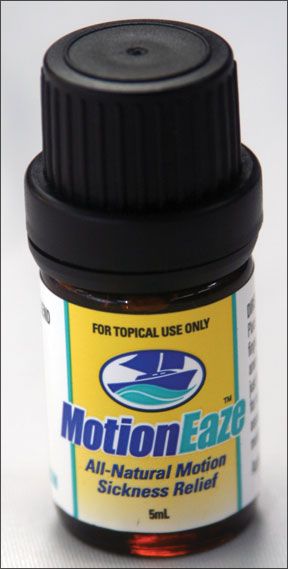
CONCLUSION
The therapy you should use is the one that works the best for you with the least side effects. Its always a good idea to take test it on land first to determine side effects. If youre a frequent sufferer of seasickness, we suggest combining the use of alternative, drug-free therapies for mild symptoms and prescription or over-the-counter meds for more severe cases. Our January look at medications found that Stugeron was the choice of most survey respondents, but its not available in the U.S. and has possible serious side effects in the elderly. Based on our survey and research, antihistamine solutions Marezine and Transderm-Scop also offer a balance between efficacy and side effects that most find acceptable. Be sure to discuss any medication you plan to take with your doctor.
Most of our survey respondents found non-drug solutions to be ineffective, and where they were effective, they worked only for mild seasickness or in mild sea conditions. More than half of the 37 survey respondents said they did not know of anyone who regularly used non-drug therapies, with the exception of ginger, to combat seasickness. The four charter skippers we polled had seen a wide variety of herbal and alternative remedies, and they all held the view expressed by Susanne Huber-Curphey, who leads all-women offshore charters: “My personal opinion is that it only works if you really believe in it…We tried ginger, the wrist bands, gallons of herbal tea, and all helped those who believed in it.”
With the exception of the electrical-stimulation bands, most non-drug remedies are inexpensive enough that they are worth trying and keeping onboard for green-gilled guests. The Explorer ReliefBand is the most expensive solution. While it does seem to be effective for some people, the experience of our respondents was inconclusive. The mild irritation of the shocks and the need to reapply the gel every few hours discouraged some from using it regularly. Our small sample group can only provide anecdotal evidence, so we are reluctant to come to any firm conclusion on it.
Of these alternative therapies, ginger proved the most efficacious based on our survey and testers experiences. It provided relief of mild seasickness symptoms for two-thirds of those who had tried it. Practical Sailor recommends carrying ginger and using it to treat mild symptoms.
We will continue to look for a non-drug therapy that reliably relieves moderate to severe seasickness. Wed like to hear your non-drug cures for motion sickness. Send an e-mail to practicalsailor@belvoirpubs.com. We received dozens of e-mails in response to our January call for recommendations of seasickness medications, and plan to report both survey results in an upcoming issue.

































